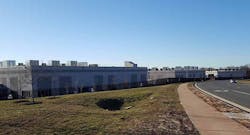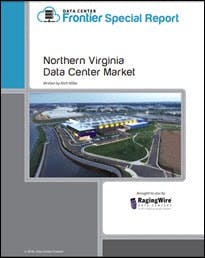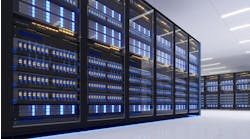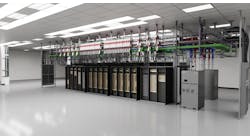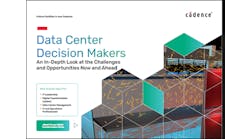It’s an economic developer’s dream scenario: Reducing the property tax rate for homeowners. Investing in schools. Hiring more new county workers, while giving raises to existing employees.
This dream has become reality in Loudoun County in Northern Virginia, boosted by an explosion in tax revenue from the dozens of data centers clustered around Ashburn.
The role of data centers in economic development has burst into view in the revenue windfall in Loudoun County. In the 2018 fiscal year, the county budgeted for $154.9 million in business computer equipment tax, but collected $195.2 million – more than $40 million more than expected. The surge in tax revenues will continue into the coming year as well.
“In 2019, data centers will contribute more than a quarter billion dollars in tax revenue in Loudoun County,” said Buddy Rizer, the county’s Executive Director of Economic Development. “It means roads, it means schools, it means a lot of things.”
“Loudoun County gave all its employees a raise and increased the budget for its schools,” said Ross Litkenhous, Global Head of Business Development for Altus Group, a real estate technology firm. “How do they do it? It’s data centers.”
The county just adopted a budget that includes a four-cent reduction in the property tax rate (from $1.08 to $1.04), a $76 million increase in funding for county schools, and the addition of 204 new positions in county government. Data centers now generate upwards of $20 of tax revenue per square foot, according to countyDirector of Management and Budget Erin McLellan.
The tax surge in Loudoun County provides an important new narrative to the long-running debate about the economic development value of data centers. Much of the public debate has been driven by critics of extending tax breaks to wealthy technology companies.
In an environment where many local jurisdictions struggle to balance their budgets, Loudoun’s success illustrates the potential for data centers to be compelling engines of prosperity.
The bottom line: Experiences vary by region and city, but there is a growing body of data affirming the impact of data centers in revenue and jobs for local economies. In an environment where many local jurisdictions struggle to balance their budgets, Loudoun’s success illustrates the potential for data centers to be compelling engines of prosperity.
A Future Filled With Data Centers
As digital transformation sweeps the global economy, Internet infrastructure will become a more meaningful part of our cities and suburbs. This is one of our key themes here at Data Center Frontier. Understanding the economics of data center development, and the costs and benefits for local communities, is a key part of this equation.
Loudoun County offers early lessons on how the Internet knits itself into the fabric of modern life, including the real-world financial benefits of data center development. Until now, economic studies have been the primary reference points on data centers as economic development tools. Meanwhile, news stories that have dominated the “cautionary tale” narrative about incentives for tech firms.
Local officials say data center tax revenue has allowed the county to buck regional trends in property taxes.
“Loudoun’s ability to continue to reduce the tax rate is unique among jurisdictions in the D.C. metro area and is driven by our extremely strong economic growth,” said Loudoun County Supervisor Matthew Letourneau (R-Dulles). “Property taxes on computer equipment, which applies to data centers, represent the largest area of growth.
“While data centers are not always everyone’s favorite type of development, at this point they are accounting for over $1,000 in tax savings for the average Loudoun homeowner,” Letourneau added in his budget analysis. “Obviously, we must ensure that data centers go in the right parcels and are good neighbors, but their growth means money in your pocket because they consume very few county resources.”
Read more: Ashburn: A Landscape Transformed by Cloud Computing
In many ways, Loudoun is an outlier case in data center development. Northern Virginia is the world’s largest data center market, and the shift to cloud computing has brought unprecedented growth. At more than 1 gigawatt of data center capacity, it is twice the size of any other market in the United States.
But Loudoun’s success has implications for a future in which data facilities become a more common component of the urban and suburban landscape. Twenty years ago, Ashburn featured lots of farmland and a modest smattering of data centers. Ten years ago, data center development was beginning to kick into gear, with focused activity by a small number of established developers.
What will the landscape look like in 20 years? The digital transformation of our economy is projected to generate an ocean of data, fed by a growing universe of intelligent things – sensors, cameras, smartphones, tablets, drones, robots and connected cars. If any of these technologies succeed, they will require lots of data center infrastructure.
The economics of data center growth – and who benefits – will become a more important economic development issue as the digital transformation unfolds.
The Economic Development Challenge
Data centers are non-traditional engines of economic development. Much of their impact occurs in the digital realm, while full-time jobs remain the key metric for economic development. Data centers boost construction employment, but the completed facilities are highly automated, and can be run by 20 to 50 people per building. The tradeoff is that they generate large amounts of tax revenue and don’t create strain on local schools and traffic.
In translating business processes from atoms to bits, data centers concentrate business activity in highly-efficient facilities. The business value created by servers and data storage devices is real, but largely invisible in a local economy. Companies buy servers and data center space because they help sell products and services faster and more efficiently.
Read More: Northern Virginia Data Center Market: The Focal Point for Cloud Growth
The business success of Amazon, Microsoft, Netflix, Uber and Facebook hums through fiber routes and data centers along Loudoun’s roads. What residents see are large, often noisy buildings with grey facades and uninspiring designs.
The unappreciated benefits of the data center equation come at rush hour, when traffic packs the intersections across Northern Virginia. There are delays at the busy intersection of Loudoun County Parkway and Waxpool Road in Ashburn. You may sit for a while.
But imagine the traffic if the properties around that intersection were filled with tens of thousands of office workers or shoppers, instead of millions of servers. That is the invisible nature of the data center dividend – along with the surging revenue on line items in the Loudoun county budget.
The Incentive Debate
More than 20 states now use economic incentives to attract data center projects, yearning to land deals with Facebook, Google, Apple, Amazon or Microsoft that would signal their transition to the new digital economy.
Incentives for data centers have become a hot button issue, with taxpayers and legislators in some states questioning the value of perks for giant tech companies. Your mileage may vary, with different towns citing different experiences with these projects, depending on the generosity of the incentives (more on this in coming days).
The economics of data center growth – and who benefits – will become a more important economic development issue as the digital transformation unfolds.
In Virginia, most data center facilities are exempt from state sales and use taxes, so long as they spend at least $150 million and create between 25-50 new jobs in the area. Those tax breaks have since been extended through 2035, providing long-term visibility into operating costs for data center operators.
Loudoun County sees a clear benefit from data center incentives. “Not only is it a lot of money in taxes, but it’s a great return on our investment,” said Rizer.
For every dollar in county expenditures, the data center sector provided approximately $9.50 in tax revenue to Loudoun County, and approximately $4.30 in tax revenue to Prince William County, according to an economic impact study by research firm Mangum Economics.
This type of success requires an alignment of the planets, including a dynamic data center market, economic development policy, and tax policy.
Tax Policy: Data Centers Often Misunderstood
When it comes to property tax issues, data centers are “in a league of their own,” according to Litkenhous, who says these properties are “misunderstood, misinterpreted, and usually overtaxed.” There’s little consistency in how data centers are taxed.
“Data centers are a godsend to most jurisdictions,” he said. “It is clearly a golden goose. But taxing jurisdictions have often failed to understand the complexities of data centers.”
Litkenhous is an expert on data center taxation, and summarized some of his experiences in a recent session at DCD New York. In addition to his real estate expertise, he serves on the city council in Falls Church, Virginia in Fairfax County, and thus has a front-row seat for the region’s data center boom.
“Data centers are a godsend to most jurisdictions. But taxing jurisdictions have often failed to understand the complexities of data centers.”
Ross Litkenhous, Altus Group
The key issue is that municipalities often don’t understand the components of the data center, how they relate to the business, and how that plays a huge role in assessment methodology. Tax assessors typically use three approaches to valuing a property:
- Business Income
- Sales comparison to comparable properties
- Replacement cost
Income and sales are the most common approaches, Litkenhous says. Loudoun County uses the replacement cost, which he says is the fairest method for data centers, as it separates the value of the building from the servers in the data halls.
“Loudoun assesses data centers as a very nice warehouse,” said Litkenhous. “The servers are the business inside, and are the personal property of the business. If it can be removed, it’s personal property. This is incredibly important to the industry and how data centers are taxed.”
Download the new Special Report covering the Northern Virginia Data Center Market.
Nearby Prince William County uses the business income method to assess data centers, Litkenhous writes, which can lead to assessments for data centers that are twice as high as an identical structure in Loudoun County.
Last year Prince William had a vigorous political discussion on data center taxation, focusing primarily on personal property taxes. Board of Supervisors Chairman Corey Stewart sought to increase the personal property tax rate for computer equipment and peripherals from $1.25 per $100 to $3.70. The $1.25 rate represented an incentive rate to attract technology businesses, while $3.70 is the rate paid by residents.
Stewart noted that in Loudoun County, data centers pay the same $4.20 per $100 tax rate as local residents. Stewart said the move could raise an additional $20 million to support increased spending on education and public safety, but also allow the county to decrease the property tax rate. The proposal failed by a 6-2 vote by the Board of Supervisors as part of a larger process to finalize the county budget for 2019.
History shows that data center development can shift very quickly when tax benefits are reversed. This can be seen in Washington State’s decision to rescind data center tax incentives that sparked a huge building boom from 2007 to 2010. The incentives were allowed to lapse in 2011 after coming under heavy criticism from legislators, critics and the media. Data center projects quickly abandoned Washington and were welcomed by next-door neighbor Oregon, which offered many of the same climate and energy sourcing advantages as Washington.
A 2018 report by the Washington State Department of Commerce summarized the impact of the lapse, which only lasted two years before most of the incentives were restored.
“The inescapable conclusion of this research is that urban western Washington has ceded its leadership in the data center cluster to urban Oregon,” the report said. “Hillsboro has experienced dramatic growth in construction, capital investment, jobs, and income that would likely have flowed to Washington in part or in total if the competitive impacts of Oregon’s tax and tax incentive advantages could have been neutralized.”

